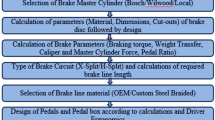Abstract
A brake pedal is a significant pedal after the acceleration pedal as it is used in controlling the vehicle’s speed. An optimized brake pedal is designed to improve the design and other parameters. FEA analysis shows that several test cycles are performed very well. In this paper, an analysis of the design of the brake pedal of a vehicle and testing the strength of the brake pedal are performed and tested according to the criterion. Brake pedal models are designed and constructed using SolidWorks 2018 software. Aluminum alloy is selected as the material for analysis. It is concluded that aluminum is good for the vehicle brake pedal at the beginning of the test. The test is performed on the pedal physical as well as internal buildup characteristics in the material as well as in the design. This study reveals more strength and durability in design with material placed at the required location.
Access this chapter
Tax calculation will be finalised at checkout
Purchases are for personal use only
Similar content being viewed by others
References
He H, Wang C, Jia H, Cui X (2020) An intelligent braking system composed single-pedal and multi-objective optimization neural network braking control strategies for an electric vehicle. Appl Energy 259. https://doi.org/10.1016/j.apenergy.2019.114172
Shi J et al (2020) Prediction of brake pedal aperture for automatic wheel loader based on deep learning. Autom Constr 119. https://doi.org/10.1016/j.autcon.2020.103313.
Wu Y, Boyle LN, McGehee DV (2018) Evaluating variability in foot to pedal movements using functional principal components analysis. Accid Anal Prev 118:146–153. https://doi.org/10.1016/j.aap.2018.02.011
Wiggermann N, Zhou J (2018) Relationships among static strength, dynamic strength, and psychophysically determined levels of acceptable force for a pushing task and foot pedal actuation task. Int J Ind Ergon 65:68–73. https://doi.org/10.1016/j.ergon.2018.01.010
Cuma MU, Ünal ÇD, Savrun MM (2021) Design and implementation of algorithms for one-pedal driving in electric buses. Eng Sci Technol Int J 24(1):138–144. https://doi.org/10.1016/j.jestch.2020.12.014
Singh YD, Varma SVM, Khakhar P (2018) Analysis on multi linkage brake system with variable pedal ratio [Online]. www.sciencedirect.comwww.materialstoday.com/proceedings
Sargini MIM, Masood SH, Palanisamy S, Jayamani E, Kapoor A (2021) Additive manufacturing of an automotive brake pedal by metal fused deposition modeling. Mater Today Proc 45:4601–4605. https://doi.org/10.1016/j.matpr.2021.01.010
Deng TM, hou Fu J, Shao YM, shuan Peng J, Xu J (2019) Pedal operation characteristics and driving workload on slopes of mountainous road based on naturalistic driving tests. Safety Sci 119:40–49. https://doi.org/10.1016/j.ssci.2018.10.011
Romero J, Queipo NV (2018) An ANOVA approach for accounting for life-cycle uncertainty reduction measures in RBDO: the FSAE brake pedal case study. Struct Multi Optim 57(6):2109–2125. https://doi.org/10.1007/s00158-018-1983-6
Kirschbaum S et al (2021) Reaction time and brake pedal force after total knee replacement: timeframe for return to car driving. Knee Surg Sports Traumatol Arthrosc 29(10):3213–3220. https://doi.org/10.1007/s00167-020-06105-2
Liu W, Qi H, Liu X, Wang Y (2020) Evaluation of regenerative braking based on single-pedal control for electric vehicles. Front Mech Eng 15(1):166–179. https://doi.org/10.1007/s11465-019-0546-x
Yusuf R, Tanev I, Shimohara K (2019) Affective computing to help recognize mistaken pedal-pressing during accidental braking. Artif Life Robot 24(2):212–218. https://doi.org/10.1007/s10015-018-0515-1
Kulangara AJ, Rao CSP, Cherian J (2021) Topology optimization of lattice structure on a brake pedal. Mater Today Proc 47:5334–5337. https://doi.org/10.1016/j.matpr.2021.06.059
Mohanta M, Kar S, Mohanta D, Mohanty AM (2018) Experimental analysis and parametric optimization of 6065-aluminium alloy in rotary friction welding, vol 8, no 1, pp 111–118
Author information
Authors and Affiliations
Corresponding author
Editor information
Editors and Affiliations
Rights and permissions
Copyright information
© 2024 The Author(s), under exclusive license to Springer Nature Singapore Pte Ltd.
About this paper
Cite this paper
Singh, C., Jain, U., Singh, R., Agrawal, B.N. (2024). Design and Simulation for Brake Pedal of Aluminium Alloy. In: Tyagi, R.K., Gupta, P., Das, P., Prakash, R. (eds) Advances in Engineering Materials. FLAME 2022. Lecture Notes in Mechanical Engineering. Springer, Singapore. https://doi.org/10.1007/978-981-99-4758-4_15
Download citation
DOI: https://doi.org/10.1007/978-981-99-4758-4_15
Published:
Publisher Name: Springer, Singapore
Print ISBN: 978-981-99-4757-7
Online ISBN: 978-981-99-4758-4
eBook Packages: EngineeringEngineering (R0)




